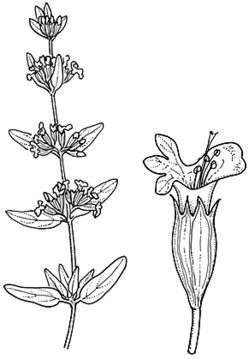Common name: Slender Mint
Mentha diemenica Spreng. APNI* Synonyms: Mentha diemenica var. serpyllifolia (Benth.) J.H.Willis APNI*

Description: Mat-forming herb, rhizomatous and often producing ascending to prostrate branches; branches ± densely covered with short recurved simple hairs.
Leaves with lamina ovate, often angular-ovate, rarely narrow-ovate or elliptic, 0.6–2 cm long, 4–12 mm wide; apex obtuse or rounded; margins entire or sometimes with distant shallow teeth; petiole 0–3 mm long.
Flowers in 3–8-flowered clusters in axil of a pair of leaves. Calyx 13-ridged, fused to at least two-thirds its length; lobes pointed or broad-acute; outer surface densely covered with short hairs, long hairs on margin. Corolla 4–7 mm long, purple, often pale. Anthers ± exserted.
Flowering: throughout year.
Distribution and occurrence: Grows in communities similar to that of M. satureioides but also occurs on sandier soils; widespread.
NSW subdivisions: NC, CC, SC, NT, CT, ST, NWS, CWS, SWS, NWP, SWP, SFWP
Other Australian states: Qld Vic. Tas. S.A. N.T.
The current circumscription of M. satureioides and M. diemenica represents the extremes of what appears to be a morphological continuum and is sometimes called the M. satureioides group. Many populations show a range of intermediates or combinations of the characters given in the key.
Text by B. J. Conn
Taxon concept: Flora of NSW 3 (1992)
APNI* Provides a link to the Australian Plant Name Index (hosted by the Australian National Botanic Gardens) for comprehensive bibliographic data
***The AVH map option provides a detailed interactive Australia wide distribution map drawn from collections held by all major Australian herbaria participating in the Australian Virtual Herbarium project.
|


